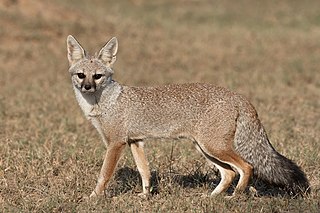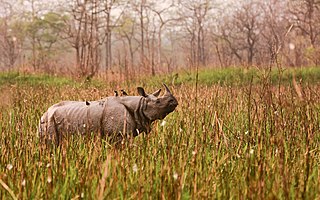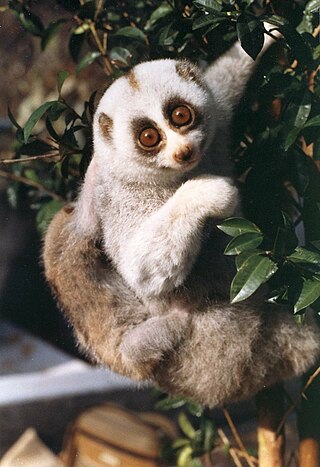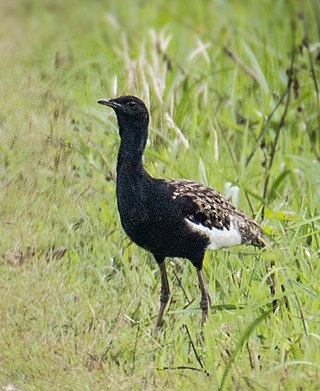
The white-rumped vulture is an Old World vulture native to South and Southeast Asia. It has been listed as Critically Endangered on the IUCN Red List since 2000, as the population severely declined. White-rumped vultures die of kidney failure caused by diclofenac poisoning. In the 1980s, the global population was estimated at several million individuals, and it was thought to be "the most abundant large bird of prey in the world". As of 2021, the global population was estimated at less than 6,000 mature individuals.

The leopard cat is a small wild cat native to continental South, Southeast, and East Asia. Since 2002 it has been listed as Least Concern on the IUCN Red List as it is widely distributed although threatened by habitat loss and hunting in parts of its range.

Monitor lizards are lizards in the genus Varanus, the only extant genus in the family Varanidae. They are native to Africa, Asia, and Oceania, and one species is also found in the Americas as an invasive species. About 80 species are recognized.

The lesser crested tern is a tern in the family Laridae.

The Bengal fox, also known as the Indian fox, is a fox endemic to the Indian subcontinent from the Himalayan foothills and Terai of Nepal through southern India, and from southern and eastern Pakistan to eastern India and southeastern Bangladesh.

Prionailurus is a genus of spotted, small wild cats native to Asia. Forests are their preferred habitat; they feed on small mammals, reptiles and birds, and occasionally aquatic wildlife.

The lesser bandicoot rat, Sindhi rice rat, bengal rat or Indian mole-rat is a giant rat of Southern Asia, not related to the true bandicoots which are marsupials. They can be up to 40 cm long, are considered a pest in the cereal crops and gardens of India and Sri Lanka, and emit piglike grunts when attacking. The name bandicoot is derived from the Telugu language word pandikokku, which translates loosely to "pig-rat". Like the better known rats in the genus Rattus, bandicoot rats are members of the family Muridae. Their fur is dark or (rarely) pale brown dorsally, occasionally blackish, and light to dark grey ventrally. The head-body length is around 250 mm, and the uniformly dark tail is shorter than the head-body length.

The Bengal monitor, also called the common Indian monitor, is a monitor lizard distributed widely in the Indian Subcontinent, as well as parts of Southeast Asia and West Asia. This large lizard is mainly a terrestrial animal, and its length ranges from about 61 to 175 cm from the tip of the snout to the end of the tail. Young monitors may be more arboreal, but adults mainly hunt on the ground, preying mainly on arthropods, but also taking small terrestrial vertebrates, ground birds, eggs and fish. Although large Bengal monitors have few predators apart from humans who hunt them for meat, younger individuals are hunted by many predators.

Orang National Park, or the Rajiv Gandhi Orang National Park, is a national park and wildlife refuge situated in northeastern India, on the northern bank of the Brahmaputra River, in the Darrang and Sonitpur Districts of the state of Assam. In total, the park covers an area of 79.28 km2 (30.61 sq mi).

The Bengal eagle-owl, also widely known as the Indian eagle-owl or rock eagle-owl, is a large horned owl species native to hilly and rocky scrub forests in the Indian Subcontinent. It is splashed with brown and grey, and has a white throat patch with black small stripes. It was earlier treated as a subspecies of the Eurasian eagle-owl. It is usually seen in pairs. It has a deep resonant booming call that may be heard at dawn and dusk.

Anguilla bengalensis bengalensis, the Indian mottled eel, is a subspecies of eel in the genus Anguilla of the family Anguillidae. It is found throughout the Indian subcontinent and neighbouring regions including the East Indies.

The mottled eel, also known as the African mottled eel, the Indian longfin eel, the Indian mottled eel, the long-finned eel or the river eel, is a demersal, catadromous eel in the family Anguillidae. It was described by John McClelland in 1844. It is a tropical, freshwater eel which is known from East Africa, Bangladesh, Andaman Islands, Mozambique, Malawi, Sri Lanka, Sumatra, and Indonesia and recently from Madagascar. The eels spend most of their lives in freshwater at a depth range of 3–10 metres, but migrate to the Indian Ocean to breed. Males can reach a maximum total length of 121 centimetres and a maximum weight of 7,000 grams. The eels feed primarily off of benthic crustaceans, mollusks, finfish and worms.

The Adan River is a river in Washim District, Maharashtra, India and a principal tributary of the Painganga River.

The Bengal slow loris or northern slow loris is a strepsirrhine primate and a species of slow loris native to the Indian subcontinent and Indochina. Its geographic range is larger than that of any other slow loris species. Considered a subspecies of the Sunda slow loris (N. coucang) until 2001, phylogenetic analysis suggests that the Bengal slow loris is most closely related to the Sunda slow loris. However, some individuals in both species have mitochondrial DNA sequences that resemble those of the other species, due to introgressive hybridization. It is the largest species of slow loris, measuring 26 to 38 cm from head to tail and weighing between 1 and 2.1 kg. Like other slow lorises, it has a wet nose (rhinarium), a round head, flat face, large eyes, small ears, a vestigial tail, and dense, woolly fur. The toxin it secretes from its brachial gland differs chemically from that of other slow loris species and may be used to communicate information about sex, age, health, and social status.

The Bengal florican, also called the Bengal bustard, is a bustard species native to the Indian subcontinent, Cambodia, and Vietnam. It is listed as Critically Endangered on the IUCN Red List because fewer than 1,000 individuals were estimated to be alive as of 2017. It is the only member of the genus Houbaropsis.
The Visayan leopard cat, known locally as maral, is a Sunda leopard cat population in the Philippine Islands of Negros, Cebu and Panay. It has been listed as vulnerable on the IUCN Red List in 2008 under its former scientific name P. bengalensis rabori as its range is estimated to be less than 20,000 km2 (7,700 sq mi), and the population was thought to be decreasing.
Phylladiorhynchus is a genus of squat lobsters in the family Galatheidae, containing the following species:
Phylladiorhynchus ikedai is a species of squat lobster in the family Galatheidae. It is found in the Indo-Pacific, from the Red Sea, Maldives, Kei Islands, New Caledonia, Loyalty Islands, and Bonin Islands, at depths from sea level to 510 metres (1,670 ft).

The Sunda leopard cat is a small wild cat species native to the Sundaland islands of Java, Bali, Borneo, Sumatra and the Philippines that is considered distinct from the leopard cat occurring in mainland South and Southeast Asia.

Filopaludina bengalensis, also known as Bellamya bengalensis, is a species of large freshwater snail with a gill and an operculum, an aquatic gastropod mollusk in the family Viviparidae.















